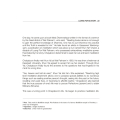self-understanding : ค้นหาหนังสือธรรมะ หน้า 44 / 52
หน้าหนังสือทั้งหมด

288
การพัฒนาจิตตามแนวทางพุทธศาสนา
พระสกthernากฏุตาย, ดูเจ็บ, ดูแก่, ดูเกิด, ของพระมหากาย เหตุให้เกิดและความดับและเหตุให้ดับ ให้เห็นตามความเป็นจริง ทุกข์, สมุทัย, นิธิโร, มรรค...แล้วศูนย์นั้นกลับเป็นธรรมกายหน้าตัก 15 วาเป็นพระอนาค ทำต่
เนื้อหาพูดถึงแนวทางการเข้าถึงความรู้แจ้งตามหลักพุทธศาสนา ซึ่งมีการกล่าวถึงธรรมกาย พัฒนาการทางจิตใจ การไปสู่การหลุดพ้นจากทุกข์ และความจำเป็นในการเข้าใจความจริงเหล่านี้ด้วยตัวเอง โดยยกตัวอย่างพระอรหันต์

62
Understanding Cross-Cultural Communication
SAPIENZA, Filipp.
2017 "Culture and Context: A Summary of Geert Hofstede's and Edward Hall’s Theories of Cross-Cultural Communication for Web Usability." Accessed October 2, http://www.filippsapien
This content summarizes the key theories of Geert Hofstede and Edward Hall related to cross-cultural communication, focusing on how these theories can enhance web usability. By understanding cultural

14
The Dhammakaya Tradition
The Dhammakaya Tradition
Founded by the Great Abbot of Wat Paknam Bhasicharoen, Phra Mongkhonpuraimi (background picture), the Dhammakaya Knowledge was passed on to Khun Yai Chan Khonnokyoong (center
The Dhammakaya Tradition, founded by the Great Abbot of Wat Paknam Bhasicharoen, Phra Mongkhonpuraimi, emphasizes the importance of knowledge in Buddhism. This tradition was further propagated by Khun

124
Luang Por Dhammajayo’s Aspiration
Luang Por Dhammajayo’s Aspiration
After Luang Por Dhammajayo took the yellow robe to become a Buddhist monk he resolved that he would preach only the subject of stopping the mind. Over the past forty
Luang Por Dhammajayo emphasizes the essential practice of stopping the mind in his teachings. His journey from a young monk to a teacher focused on the importance of both reading and practicing Dhamma

12
Asapurisaḍāṇa Sutta - The Worthiness of Gifts
2. Asapurisaḍāṇa Sutta
Bhikkhus, these five are unworthy gifts.
What five ?
Giving disrespectfully,
giving without heart and thought,
not giving with one’s own hand,
giving something which is to be d
The Asapurisaḍāṇa Sutta explains the nature of giving in Buddhism, distinguishing between unworthy and worthy gifts. Unworthy gifts include those given disrespectfully, without thought, not given from

14
Sappurisadana Sutta: Gifts of a Person of Integrity
3. Sappurisadana Sutta8 :
A Person of Integrity's Gifts
"These five are a person of integrity's gifts.
Which five?
A person of integrity gives a gift with a sense of conviction.
A person of integrity
The Sappurisadana Sutta describes five essential gifts that characterize a person of integrity. These gifts include giving with conviction, attentiveness, in an appropriate time, with empathy, and wit

38
The Virtue of Abstaining in Dakhina-vibhanga Sutta
The Virtue of Abstaining
6. Dakhina-vibhanga Sutta
the virtues loved by noble ones.24 It is owing to the Blessed One that Mahā paja pārī Gotāmī is free from doubt about suffering, about the origin of
The Dakhina-vibhanga Sutta highlights the significance of abstaining from harmful actions such as killing and immoral conduct. It illustrates how one's journey towards refuge in the Buddha, Dhamma, an

46
The Significance of Giving to Spiritual Seekers
"By giving a gift to one who has entered upon the way to the realisation of the fruit of stream - entry, the offering may be expected to repay incalculably, immeasurably.
What, then, should be said a
This text examines the immense value of giving to those who are on the spiritual path, highlighting the exponential returns of such acts. From stream-enterers to Tathāgatas, offerings made to these en

52
Dakkhīnāvibhaga Sutta: The Purity of Offerings
52
The Virtue of Absorbing
6. Dakkhīnāvibhaga Sutta
There is the offering that is purified by the giver, not by the receiver.
There is the offering that is purified by the receiver, not by th
The Dakkhīnāvibhaga Sutta discusses the concept of offering purification by the giver and receiver. It differentiates four types of offerings: purified by the giver, by the receiver, by neither, and b

61
The Pali Language and the Theravadin Tradition
NORMAN, K.R.
1983 “The Pali Language and the Theravadin Tradition.”
A History of Indian Literature: 1-2, edited by Jan Gonda. Wiesbaden: Otto Harrassowitz.
PEW Research Center.
2017 “World Bu
This text discusses the significance of the Pali language within the Theravadin Buddhist tradition. It examines its historical roots, literary contributions, and the ongoing impact on Buddhist practic

19
The True Purposes of the Five Rooms in Life
The True Purposes of the Five Rooms in Life
Room Purpose(s)
Bedroom To build up courage by
1) doing good deeds
2) pra
This text outlines the distinct purposes of the five rooms in life: Bedroom for courage, Bathroom for vitality, Kitchen for energy, Dressing Room for intelligence, and Workroom for wealth. Emphasizing

102
Understanding the Right Way to Achieve Relaxation
How Do You Know Whether You’re Doing It the Right Way?
If you’re doing it the right way according to the right Knowledge (Vijja), your body will feel relaxed and at ease. Your mind will also feel rel
In achieving relaxation, if done correctly according to the right knowledge (Vijja), both body and mind will feel at ease. Initial feelings of contentment evolve into a lighter, more spacious existenc

92
The Victory of Abandoning: Insights from the Dana Sutta
The Victory of Abandoning
9. Dana Sutta
Those 6 things Then, having exhausted that action, that
power, that status, that sovereignty, he is a returner,
coming back to this world.
7. "-- but with the
The Dana Sutta presents profound insights on the nature of giving and its consequences in the spiritual journey. It describes how the mindset behind acts of generosity can influence their outcomes—whe

3
Memorandum of Understanding (MOU) Signing Ceremony on December 22, 2013 by 7 Core Organizers of The Light of Peace Event in The Philippines 2014

14
Exploring the Essence of Dhammakaya Meditation
TABLE OF CONTENTS
6 A Moral Hero
14 Luang Por’s Story
36 Phramongkolthepmuni
Discoverer of the Dhammakaya Meditation Method
46 Khun Yai Chand Khonnokyoong
Founder of Wat Phra Dhammakay
This text provides an overview of the Dhammakaya meditation method, highlighting significant figures such as Luang Por and Khun Yai Chand Khonnokyoong. It elaborates on various aspects of meditation,

27
The Journey of Chaiyaboon in Meditation
One day, he came upon a book titled Dhammakaya written in the format of a sermon by the Great Abbot of Wat Paknam, who said: “Reading books alone is not enough to gain the perfect knowledge of Dhamma.
Chaiyaboon's quest for true understanding of Dhamma led him to the teachings of Khun Yai Chand at Wat Paknam. Through her guidance, he realized the reality of heaven and hell, the importance of medita

46
The Journey of Candasaro Bhikkhu: A Monk's Path to Enlightenment
He pondered about what he should do with his life, and came to the conclusion that there was nothing more worthwhile for him to do than pursuing a life of purity by becoming a monk. He made the resolu
Sodh, later known as Candasaro Bhikkhu, decided to pursue a life of purity by ordaining as a monk at the age of 22. He practiced meditation relentlessly and sought the guidance of esteemed teachers ac

30
The Four Positions of Catuskoti in Mahāyāna Buddhism
Ruegg, David Seyfort.
1977 The use of the four positions of the Catuskoti and the problem of the description of reality in Māhāyana Buddhism. Journal of Indian Philosophy Vol.5: 1–171. cited in Wester
This text examines the use of the four positions of the Catuskoti in Mahāyāna Buddhism and its significance in the understanding of reality. The philosophical underpinnings of Nāgārjuna's Madhyamaka a

18
Our Daily Conduct in Different Rooms
Our Daily Conduct
Morning to Evening
Bed room
Bath room
Kitchen room
Dressing room
Work room
Each Person
Evening to morning
Work room
Bed room
Bath room
Each Person
Kitchen room
Dressing room
Each pe
This content examines how individuals conduct themselves in different rooms throughout the day, highlighting the significance of each space—bedroom, bathroom, kitchen, dressing room, and work room—in

100
The Path to Inner Calm and Awareness
Make sure there are no signs of tension anywhere and that you're closing your eyes the right way. Create a feeling of ease, happiness and purity. Feel that you're entering upon a perfect state of calm
This text encourages a deep sense of calm by detaching from worldly concerns and realizing the temporary nature of existence. It highlights the importance of the Seventh Base of the Mind, an integral
